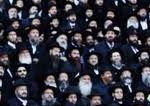Jewish spiritual leaders – Ask the Rabbi
Q. Are rabbis the only type of Jewish spiritual leaders?
 A. Judaism has always had its priests, poets, prophets and pedagogues, its masters and mystics, saints and sages, charismatics and characters. The destruction of the Temple replaced the kohen (priest) with the sage, later called the rabbi.
A. Judaism has always had its priests, poets, prophets and pedagogues, its masters and mystics, saints and sages, charismatics and characters. The destruction of the Temple replaced the kohen (priest) with the sage, later called the rabbi.
Some rabbis were also kohanim or poets. Some had a prophet-like quality. But their chief characteristic was not lineage but learning, not poetry but pedagog.
Rabbinic ordination, s’michah, the “laying on of hands”, linked every rabbi with Moses, the first rabbi. The original s’michah lapsed, but the rabbi was the scholar in residence, the student, the teacher, the exemplar of Torah.
At first rabbis did not take a salary. They were scholars who followed a range of trades and professions. Hillel was a woodcutter. Shammai a builder. There were blacksmiths, bootmakers and even a gladiator. Only in the 15th century did a salaried rabbinate develop as a reluctant concession to the conditions, but the rabbinic emphasis was still academic. Rabbis were scholars and teachers, writers and judges. Few were preachers in the modern sense.
With the 18th century came a new type, the Chassidic tzaddik. The masses in Europe felt alienated by rabbinic intellectually. They needed motivators and inspirers. There was a tug-of-war between rabbis and tzaddikim and their respective followers, until a modus vivendi recognised that both were imperiled by the same Haskalah.
About a century later, German Jewry developed the Rabbiner, moulded both by traditional texts and the modern intellectual challenge. Anglo-Jewry for its part created the minister, usually called Reverend. He looked, dressed and acted like a pastor. He had preaching and pastoral skills, but he often lacked halachic knowledge.
The post-Holocaust era has seen a resurgence of halachic study as the keynote of rabbinic leadership. In some circles, this is unaccompanied by general education, but usually the rabbi learns to unite the terminology of the Talmudic text with the idiom of the modern intellectual. In many cases the rabbi is also a minister, but the rabbi prefers to be a rav, and the community is thirstier than ever before for the tradition to which the rabbi is the key.
There were times when you could not recognise the rabbi from his appearance. He looked, dressed and acted like a pastor. A beard is still not the universal adornment of every rabbi. Nor does black have to be the dominant colour of his garments or hat.
So how do you recognise a rabbi? There is a Hebrew phrase, tzurat harav, “the shape of a rabbi”. In some cases it is a physical, visible characteristic. More important is the moral tzurat harav, the rabbi who earns respect for Torah by his integrity and way of the life, and the intellectual tzurah, the rabbi who knows who does not know it all, the rabbi who may be learned but, more importantly, is constantly learning – a Talmid chacham, not a finished product.



